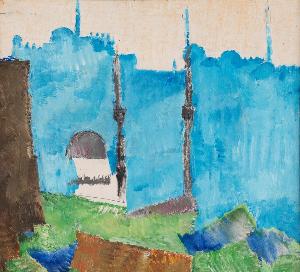Oleksa Hryshchenko
Oleksa Hryshchenko;Alexis Gritchenko
Stílus: Expressionism;
Hely: Krolevets
Született: 1883
Halál: 1977
Életrajz:
Early Career
In 1911, Oleksa Hryshchenko visited Paris, where he became an enthusiast of modern art, especially Cubist painting. After a trip to Italy in 1913-1914, he blended his study of early Italian Renaissance painters with his own style, creating a unique blend of the cosmopolitan and urbane with the orthodoxy of the Byzantine legacy of sacred art. Theoretical Work
Oleksa Hryshchenko devoted his theoretical work to the subject of Byzantine art and its links with modern art, analyzing the formal and stylistic properties of Byzantine painting in terms of modernist tendencies and practice. He published several books and articles, including studies on the icon in relation to Western art. Later Career
After the 1917 revolution, Oleksa Hryshchenko became a professor at the Free Art Studios (Svomas) in Moscow and a member of the Commission for the Preservation of Historic Monuments. In 1919, he was offered the directorship of the Tretyakov Gallery, but decided to leave Russia by way of Crimea to Constantinople, leaving all his paintings and other possessions behind in Moscow. Artistic Style
Oleksa Hryshchenko's artistic style is characterized by its unique blend of traditional Ukrainian motifs with modernist tendencies. His use of color and composition creates a sense of harmony and balance, reflecting his interest in Byzantine art.
Important aspects of Oleksa Hryshchenko's life and work include his unique blend of traditional Ukrainian motifs with modernist tendencies, as well as his contributions to the development of Byzantine art. His legacy continues to be celebrated through his paintings, which can be found in various museums and collections around the world. Oleksa Hryshchenko's biography is a testament to his dedication to art and his contributions to the development of modern Ukrainian art. Oleksa Hryshchenko passed away in 1977, leaving behind a legacy of beautiful paintings and a lasting impact on the art world.





